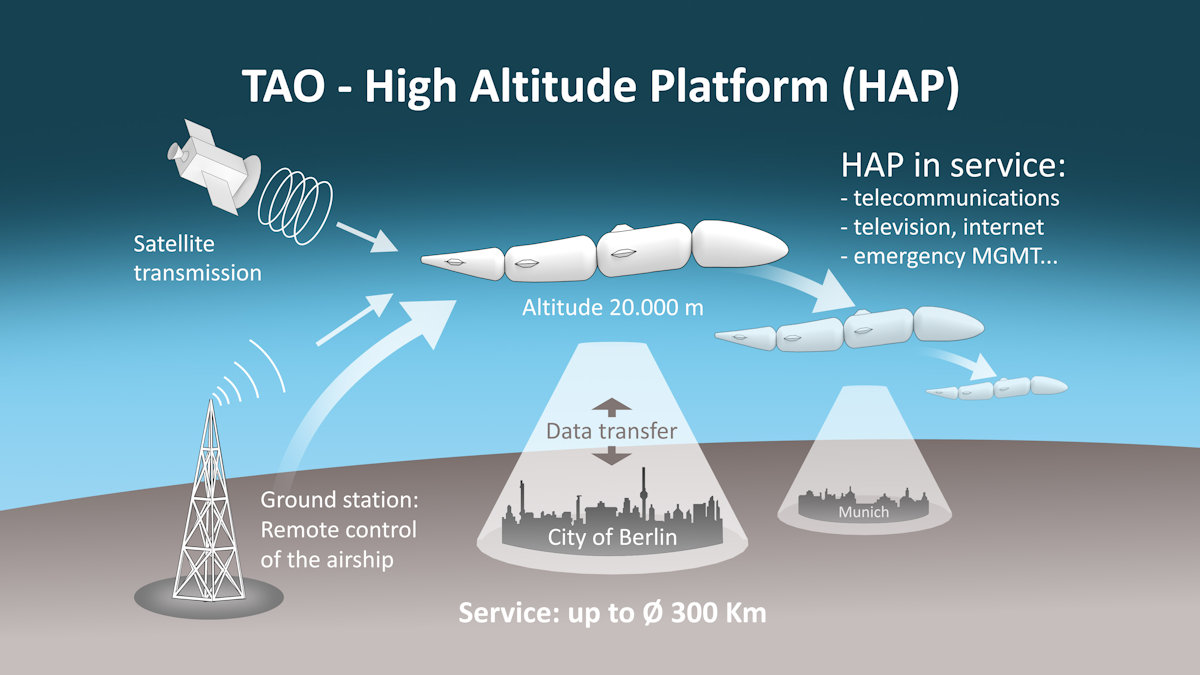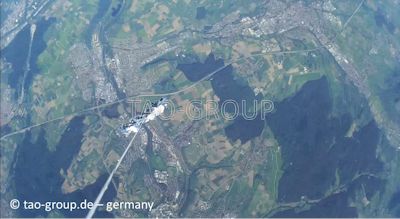High Altitude Platform for Telecommunication
The path breaking innovative concept of the TAO “High altitude platform” – a segmented airship flying at 20 km altitude in the stratosphere – to provide telecommunication and telemetry is a cheap future oriented method to solve the future problems of telecommunication all in reducing radiation near the user.
The technical idea was originally conceived in 1996 by Prof. Dr. Bernd-Helmut Kröplin. In 1990 the technology was awarded with the most outstanding European prize for research in industry. The first prototypes have been tested in flight in 2002/2003. Actually various sizes of the lighter than air vehicles have been tested in Germany.
TAO High Altitude Platform “SkyDragon”

1. The Mission of the HAP
The goal is obviously to have these TAO-SkyDragon High Altitude Platform fly at an altitude of 20’000 meters.
- Compared to the actual antenna masts the new system has a much higher broadcasting efficiency with substantially less electro magnetic radiation.
- The system has no dead spots.
- No space crap. Easy technical maintenance as the system is able to be launched and return to the ground by its own means. There is a 99.9 % reliability made possible by an intelligent back-up solution.
2. Places and fields of application
Preferential places of application will be densely populated areas or extensive areas as interlinked groups of islands with actually poor infrastructure. This can be considered on a global scale. The field of usage are telecommunication/radio. Transmission of information of various nature (TV – and radio broadcasting, video conferences, navigation services, transmission of sports events etc.) GPS, Coast line protection and land survey. All these applications will have to deal with substantially reduced technology cost for telecommunication. There are a number of studies on cost effectiveness and market analyses, which have been made.
3. The High Altitude Platform Technology
The TAO-High-Altitude-Technology (HAP) follows a new bionic development path: we use airship-like segments, which are connected together like a flexible chain. This concept is able to fly in high altitudes, is stable and steerable (stratospheric airship). This segmented principle is superior to airship and airplane concepts for high altitudes. The propulsion of the TAO SkyDragon-HAP-concept is solar-electric with a airweight fuelgas or with fuel itself. Our development began in 1996, got in 1999 the Körber award for the concept of High Altitude Platforms (the highly remunerated European science award) and it has been optimezed until today in our research and development. We built over 100 HAP-prototyps of different types to test all relevant parameters in real flight. Beside fuelgas propulsion we also developed a special mounting for the propulsion under the first segment of the airship or around the first segment like a ring - we call it the ring-propulsion.
Especially the fuelgas-propulsion allows a long endurance mission, also during clouds.
We can carry payloads between 10 kg and 1500 kg - depending on the airship-size. For this reason this TAO High Altitude Platform is applicable for a stationary monitoring mission (weather, disaster warning) and as a flying antenna mast for telecommunication over a defined service area.
The technical approach differs fundamentally from the way other company tried to tackle the problem of high altitude platforms. HAP will be positioned in the lower stratosphere. At this altitude we have wind speeds of up to 130 km/h and an outer temperature of -60 degrees Celcius.In fact this technology is actually the only one in the world being able to remain at this altitude and under these conditions for a long laps of time. The launching operation, the positioning of the vehicle and its return to the ground including all controlling operations of the HAP are accomplished by a ground station.
4. Competitors
The SkyDragon system has a substantial technological advance on potential competitors, which may be estimated time wise as much as four years. The advantages of the system compared to conventional systems vary according to the systems it is compared with (antenna masts, satellites, airships high flying aircrafts). We may sum up that the High Altitude Platform technology will be cheaper and more efficient as the actually applied systems. This will apply as much to the investment as to the operating costs. Detailed analyses have been made.
5. Technical Status
The development started in 1996. During the first years the development of the technology was financed by private investors and the prize money won with the European research prize. Actually there are more than 40 successfully tested prototypes (demonstrators) in the hangars. The research work is implemented in Stuttgart.
You are also kindly invited to have a look at the various press releases on the technology.

TAO High Altitude Platform
